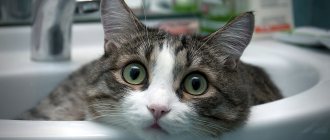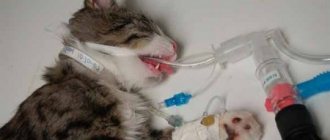Should domestic cats be washed?
Nature provides the ability for a cat to wash itself. In this she is helped by a rough tongue (effectively removes dirt), saliva with antibacterial properties, which has a detrimental effect on pathogenic particles, and flexibility. Usually this is enough to keep it clean and not get sick. But pets live close to people, which means more frequent care is required for the pet.
It is recommended to bathe a cat in the following cases:
- if the pet often walks for a long time in the courtyard of a private house;
- kittens are introduced to water procedures when they grow up a little - at 4 months of age;
- if the animal is very dirty, and the dirt can be in one area or throughout the body;
- when an animal suffers from purulent discharge, which dries out and tightens the fur;
- according to the veterinarian's indications;
- an unpleasant odor appears from the wool;
- when a cat was picked up on the street, provided that the fur is in poor condition (dirt, blood, pus).
Considering that cats learn to lick themselves from their mother from birth, they do not need additional care (except for the cases listed above). For this reason, any contact with water in large quantities is stressful for a pet. There are cases when a cat soon died after bathing.
In some cases, you cannot bathe your pet:
- during the acute phase of the disease;
- when the temperature is elevated;
- during treatment of a cat for ectoparasites: 2-3 days before the treatment procedure with special means and after the same interval after its completion;
- severe stress when bathing;
- when do you plan to see a veterinarian in the near future?
Important! If an animal is brought home from a shelter, it should not be washed immediately. For cats, a change of environment is stressful. Hygiene procedures will only increase nervous tension. They need to be put off for a few days/weeks.
Castration: why?
In order to avoid typical behavioral problems with an older cat, castration is performed - surgical removal of the gonad. As a result, the cat:
- Stops showing aggression;
- It becomes calmer;
- Starts to play (age does not affect activity);
- Stops leaving marks.
In most cases, castration does not cause any harm to the cat, which is why this method is popular. If the pet is completely healthy, then it quickly recovers from anesthesia. However, for some time it requires additional care.
© shutterstock
How often should you wash a cat living in an apartment?
There are no clear guidelines on bathing your pet. There are only recommendations that should be followed, taking into account the above conditions:
- the maximum permissible frequency of bathing cats is once a week, but it is better to increase the interval between hygiene procedures;
- the most suitable option for cats that constantly live at home is 1-2 times a year;
- Pets that live close to humans, but have the opportunity to walk independently in the surrounding area, should be washed every 3-4 months, and attention should be paid to the degree of contamination of the fur.
Toilet
As soon as the cat begins to stand up, it is necessary to place a litter tray with low sides near the bed. It is better to add a filler (silica gel is better, it does not create dust and dirt) that is light in color, so that you can immediately see if there is bleeding or pus.
If the cat avoids the toilet in the first days, this is understandable. Firstly, he had hardly eaten or drunk anything yet. Secondly, he experiences pain and discomfort and delays this moment. As a last resort, you can give your pet a little Vaseline oil.
It’s also okay if the cat goes to the toilet in small portions. This is normal for the first days. Within a month everything should be back to normal. And, most importantly, the urine will no longer have a pungent odor.
What you need to bathe cats
You should not purchase too many accessories and cosmetics. All you need to do is prepare everything you need:
- choose what to wash your pet with: you will need a special shampoo for animals, because... when using products intended for caring for the human body and hair, cats often develop dandruff and ulcers may form;
- the towel must be separate;
- When you need to fight fleas, buy anti-parasite shampoo.
Tip: If you don’t have a suitable cat fur care product on hand, you can use baby soap or shampoo once.
How to bathe cats correctly
They start with the preparatory stage. First, the animal's claws are trimmed. If your pet tolerates exposure to water well, you can immediately proceed to hygiene procedures. In other cases, you need to protect yourself by removing the cat's claws. It is better to feed the animal after water procedures, as vomiting may occur due to stress.
Further actions:
- There should be no bottles or small household appliances (hair dryer, etc.) nearby. Everything is removed so as not to create a dangerous situation (the pet may break out when it is washed).
- You need to pour warm water (+37°C) into the container. A sufficient volume of liquid is a few centimeters above the bottom. It is not recommended to completely immerse your pet in water; you need to water it from a ladle.
- You should put a mat or towel on the bottom, as your paws will slip in the water.
- There is no need to securely restrain your pet. Such actions are an alarm signal. It is recommended to hold the animal firmly, but at the same time gently.
- While bathing, you need to constantly talk to your cat. A calm, confident, but at the same time gentle voice will calm her down.
- Use a small amount of shampoo. First, apply to the body and paws, gently lather the fur. The head is washed last, because water can get into the ears, and this will lead to undesirable consequences (diseases).
- You should wash off the shampoo with your hands, and not from the shower: take water with your palms.
- Remove excess moisture when bathing is finished. At the same time, lightly squeeze out the fur in areas where there is more of it: paws, chest, tail.
- The pet is wrapped in a towel and taken out of the bathroom. The air temperature at home must be high enough (+22°C or more), otherwise the animal may get sick.
You need to give your pet the opportunity to clean itself up on its own. You should not dry the coat with a towel or blow dry it.
Tip: It is not recommended to shower your cat while bathing. These sensations will be new to him, and the loud sound of water will increase his fear.
Preparing for surgery
The preparation of any unique procedures does not require; it is enough to follow a few rules:
- The pet should not be fed 12 hours before surgery. The last meal should not be dense.
- It is not recommended to give the animal water 1-2 hours before the intervention.
- If the cat is dirty, then 3-4 hours before castration he should be washed, dried and allowed to dry.
- 2 weeks before surgery, the pet is vaccinated or given antiviral serums.
- 5. Before vaccination, deworming should be done and the animal should be rid of fleas and other blood-sucking parasites.
Kitten's first bath
The risk of developing colds due to temperature changes in children is much higher. For this reason, negative factors are excluded: drafts, cold air at home.
It is recommended to wait until the teeth are completely replaced. After this, you can wash the kitten, but wait an additional 2 weeks. The sequence of actions is the same as when bathing older pets.
First you need to show the kitten that water is not dangerous:
- the animal is transferred to a small container, only the paws are wet for now, and the rest of the body can be washed when the baby gets used to the new environment;
- To distract the kitten, they leave toys, blow bubbles for the same purpose, or perform other entertaining tricks.
Special shampoos for washing
If your pet was sterilized during the day, and in the evening he got dirty and needs to be bathed, you can use dry shampoo. The product is applied only to the areas of contamination, rubbed in, and then combed out thoroughly. Wool does not need to be washed with water.
It is better to wash a cat after castration with shampoos for kittens. They are hypoallergenic and contain fewer chemical additives. Good shampoos are from manufacturers such as: Trixie, 8in1, Beaphar, VetExpert.
All information posted on the site is provided in accordance with the User Agreement and is not a direct instruction to action. We strongly recommend that before using any product, you must obtain a face-to-face consultation at an accredited veterinary clinic.
Source
Adult cat's first bath
If you happen to take an older animal into your home, you need to understand how to bathe it in order to reduce stress. To begin with, it is recommended to familiarize the animal with the environment: it is brought into the room, you can even put it in the bath. Soon after this, you are allowed to wash your pet.
Adult cats that have not previously been in contact with large amounts of water should also be actively distracted from the procedure at first: toys are placed at the bottom of the bath; the more interesting and varied they are, the easier it is to entertain a new friend.
You need to introduce the cat to water gradually: first, pour the liquid to a level of 2-3 cm above the surface of the bathtub or basin. Gradually the amount of liquid is increased. The bathing procedure is standard.
Important rules for the owner
- In the first week after castration, the cat should not be allowed outside; it should be protected from active play at home in order to maintain the integrity of the stitches and prevent them from becoming infected.
- It is mandatory to use a special collar, which can only be removed when eating. You will have to wear it for at least a week.
- You should not bathe your pet in the first few weeks after surgery.
The cat may experience pain for several days, which can be treated with painkillers recommended by the doctor. If the pain lasts more than two days, you should consult a doctor, as this may indicate the presence of a hematoma or inflammation.
How often to bathe cats of different breeds
Recommendations:
- Representatives of the Scottish Fold breed are usually not bathed;
- hairless cats produce sebum more intensely, so they need to be washed once a month, but these animals usually love water treatments;
- cats with light hair require more careful care; they can be bathed more often than animals of other colors;
- if the pet is overweight, it is physically difficult for him to lick himself; in this case, it is also allowed to wash the cat monthly.
Care after castration: does the cat hurt, condition on the first day
If the cat is old or has liver or kidney disease, some medications are not recommended, so it is better to leave their choice to the doctor.
You CANNOT treat a cat with human painkillers.
Many human drugs are toxic to cats. In particular, never give cats panadol or paracetamol (also known as acetaminophen)!
Keep the cat in an enclosed, quiet room. If children or other animals run around it, they may accidentally damage the stitches, which will cause pain in the cat. In a calm state, the pain should gradually subside.
Seasonality. Is it possible to wash cats in winter?
During the cold season, temperature changes can affect the weather, sometimes causing colds in cats.
In winter, it is recommended, if possible, to stop washing for a while (until spring).
If, due to the nature of its life, the animal needs regular bathing, you can increase the interval between grooming procedures. In this case, the cat should be washed every 2 months. Such terms are agreed upon for cases where, under normal conditions, the animal is bathed monthly.
Postoperative complications
Like people, animals tolerate surgical interventions in their bodies differently. Sometimes even a simple castration procedure can cause health complications.
- Disturbances in the functioning of the heart.
- Breathing rhythm disturbances.
- Swelling of the tongue or eyelids.
- Pallor of mucous membranes.
- Complications may include a sharp deterioration in character. The cat is nervous, bites, and does not allow contact even with its beloved owner.
Such symptoms should cause alarm to the animal owner, and the cat should be immediately taken to a veterinarian.
Bleeding may result from poor constriction of blood vessels at the wound site. Another reason is poor blood clotting as a feature of the body. You should monitor whether the cat often licks the wound, and put a protective collar on it.











